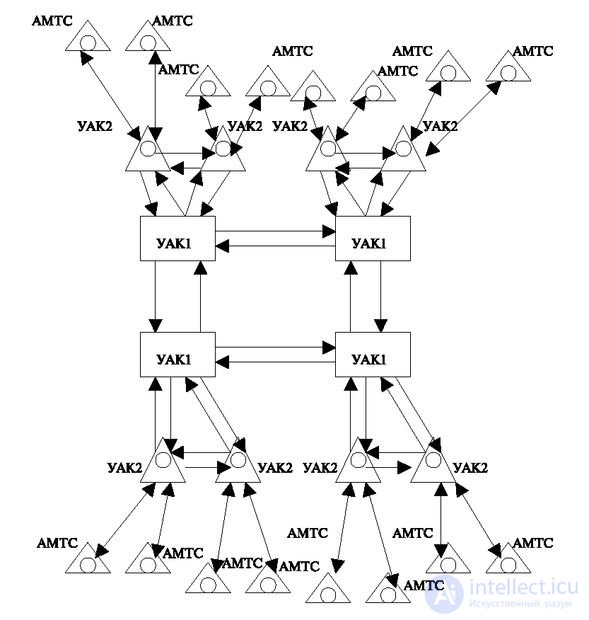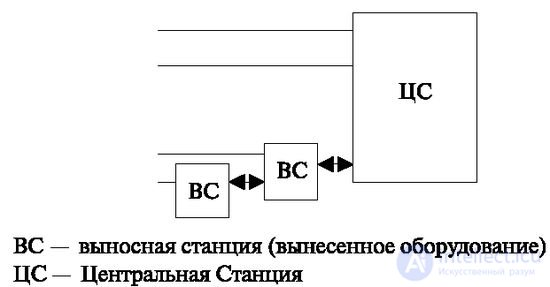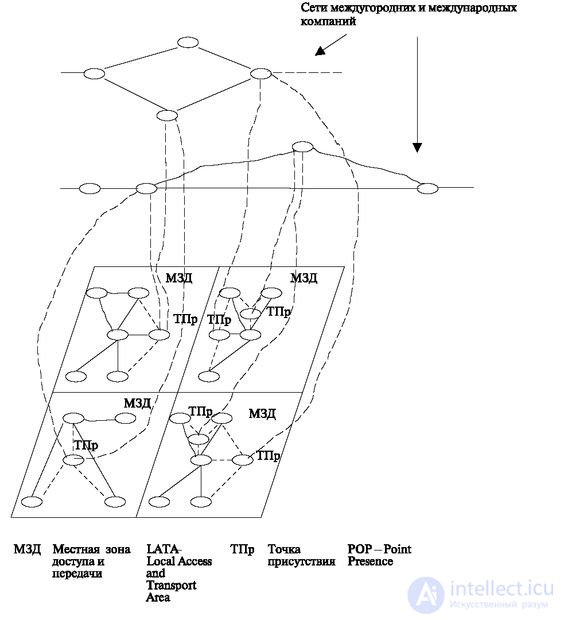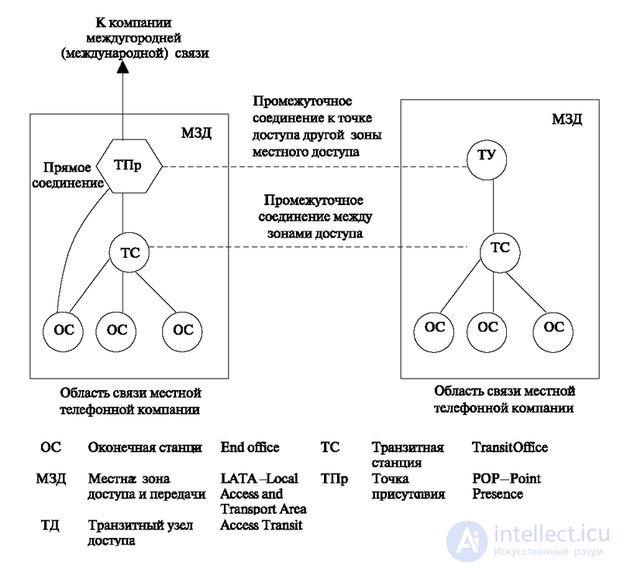Lecture
Intercity networks are built on a hierarchical basis (Fig. 8.4).

When building a long-distance network on the lower level are Automatic Intercity Stations (AMTS). Their connection to the city network was shown when considering the city network. In the rural network, they connect to the Central Station. AMTS serve one or several million zones, in large cities there may be several AMTS.
All AMTS are included in the Node 2 Automatic Switching Nodes (UAK2).
The main load between the zones passes along the lines between UAK2. All excess load passes through UAK1, which are connected according to the principle “every with each” and designed for transmission of the telephone load with small losses. The paths between UAK1 are called “paths of the last choice”, since these paths are used only when there are no paths between UAK2.
Modern digital stations, as we have seen in previous lectures, have a large subscriber capacity and the number of connecting lines. Recall that at present the specific subscriber capacity can reach 300 thousand numbers. When plugged directly into the station, the length of the subscriber line will be very large, since such a concentration of subscribers in a small radius almost does not occur.
Therefore, all modern stations are designed to install individual units closer to the area of subscriber concentration [24, 30, 42, 57.64, 65]. This reduces the length of the line and decreases their number (Fig. 8.5).

Such a solution is especially advantageous in a rural network, where a small area has a small number of subscribers.
In fig. 8.6 shows two stages of removal of equipment. In most systems, takeaway can be up to five such steps.
In the above form, the network architecture had the following disadvantages:
Over the past 20 years, the structure of public telephone telecommunications networks has changed.
The main factors that changed the approach to the network were:
In fig. 8.6 shows the separation of the US network after the collapse of January 1, 1984, the monopolist in providing telecommunications services in the US market - AT & T [5].
Consider this network as an example of demonopolization.
The network is formed by local operators (Local Exchange Carrier), serving a small geographic area - the local access and transport area (LATA). In fig. 8.6 4 local zones are shown.
Local and regional access zones belong to private companies (LEC - Local Exchange Carrier) and regional companies of BELL (RBOC - Regional Bell Operating Company). These 7 regional companies (Ameritech, Bell Atlantic, Bell South, NYMEX, Pacific Bell, Southwestern Bell, US West) serve 7 US regions and provide service to local access zones. Each private and regional company supports only the local zone and traffic within this zone, even if the local company is part of a regional company. Communication between the zones is provided by long-distance telecommunications companies such as AT & T, MCI, US Sprint. These companies belong to the trunk circuit switched circuit and packet switched lines. In fig. 8.6 two inter-city networks are shown.

Each local access and transmission zone interacts with a long-distance (international) zone through a point called the Point of Presence (POP). It is a station that aggregates traffic from local areas of access to the long-distance network and distributes traffic from the long-distance network. The connection of stations with the station "point of presence" and with stations of a long-distance network is shown in the figure by a dashed line.
In fig. 8.6 shows the following options:
Note that one intercity network is connected to the local access zone.
In fig. 8.7 shows the principle of building a local access zone.
In this example, the zone contains two local networks, each of which includes OS end stations (End Office) and transit stations (Transit Office).
Note that the exit to the long-distance network is carried out from both networks through one point of presence - an additional transit node is installed on one of the networks to connect to the point of presence. As a rule, only the transit station is connected to the end point of presence, but it is sometimes possible to use direct connections.
When distributing functions, it should be noted that the functions of determining the cost in inter-area communication are assigned to long-distance networks, and the functions of automatic number identification are assigned to the station of the local access zone. Within the local access zone it is possible to use its own cost determination system.
At the same time, in order to preserve competition opportunities, prices for local network services, revenue sharing between local and long-distance networks, additional services and special services are mutually unrelated.
Another requirement is the ability of the subscriber to change the provider without changing the subscriber number. The introduction of competition in the provision of local communications has led to a distinction between the types of network operators.
Long-distance companies should provide the same priority to local access zones. It also means that long-distance companies must provide the same quality and cost of services to local access zones of the same type.
To refer to a commercial operator and an operator representing the interests of the state, the following terms are introduced:
In conclusion, we note that before the division of the network, there were cases when the monopolist (AT & T) provided some collective users with half-speed channels, distributed access to the network according to different priorities, at different costs.

The above division is of an administrative nature; in its functions, the network stations belong to one of the groups of networks considered earlier.
Local access stations operate as urban or rural (as a whole or as part of these networks).
Stations owned by long distance and international communications companies perform the functions shown in Fig. 8.5.
Thus, taking into account the requirements of administrative division, all stations functionally fit into the rules intended for the public telephone network (numbering rules, norms and other technical rules).
Comments
To leave a comment
Telecommunication Services and Devices
Terms: Telecommunication Services and Devices